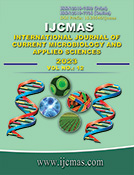


 National Academy of Agricultural Sciences (NAAS)
National Academy of Agricultural Sciences (NAAS)

|
PRINT ISSN : 2319-7692
Online ISSN : 2319-7706 Issues : 12 per year Publisher : Excellent Publishers Email : editorijcmas@gmail.com / submit@ijcmas.com Editor-in-chief: Dr.M.Prakash Index Copernicus ICV 2018: 95.39 NAAS RATING 2020: 5.38 |
This study is the first to use pupal pigmentation of the ladybug H. axyridis, a species from Kuwait, to identify sex prior to adult emergence. Twenty adults were collected from fields and reared under laboratory-controlled measures. Based on preliminary observations, it was hypothesized that orange pupae would develop to females, whereas males would emerge from dark pupae. 100 orange & 100 dark brown were collected from the second generation of the reared colony and each reared under similar laboratory conditions. Ninety-seven orange pupae developed into females, whereas 94 dark brown pupae developed into males. Another two hundred pupae were collected randomly from the field, each in a separate Petri-dish, and were left to grow in the field. Ninety-six percent of orange pupae developed into females, whereas ninety-nine percent of males developed dark brown pupae. For validation, the mean total area of melanin pigmentation present on the dorsal surface of pupae was measured using Image-J software and the results revealed significant variations for both field and laboratory samples of different colors. The overall outcome was consistent with the proposition that the pupal dimorphic colorsare sex-specific and could be applied to identify the sex prior to adult emergences in H. axyridis.
 |
 |
 |
 |
 |